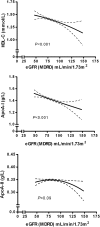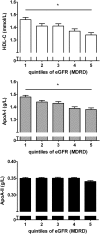Lower HDL-C and apolipoprotein A-I are related to higher glomerular filtration rate in subjects without kidney disease
- PMID: 20211930
- PMCID: PMC2882715
- DOI: 10.1194/jlr.M005348
Lower HDL-C and apolipoprotein A-I are related to higher glomerular filtration rate in subjects without kidney disease
Abstract
Animal experiments show that the kidney contributes to apolipoprotein (apo)A-I catabolism. We tested relationships of HDL cholesterol (HDL-C) and apo-I with kidney function in subjects without severe chronic kidney disease. Included was a random sample of the general population (part of the PREVEND cohort). Kidney function [estimated glomerular filtration rate (e-GFR) by two well-established equations and creatinine clearance], HDL-C, triglycerides, apoA-I and insulin resistance (HOMAir) were measured in 2,484 fasting subjects (e-GFR>or=45 ml/min/1.73 m2) without macroalbuminuria, cardiovascular disease, diabetes, or the use of anti-hypertensives and/or lipid-lowering agents. HDL-C (r=-0.056 to -0.102, P<0.01 to <0.001) and apo A-I (r=-0.096 to -0.126, P<0.001) were correlated inversely with both GFR estimates and creatinine clearance in univariate analyses. Multiple linear regression analyses also demonstrated inverse relationships of HDL-C and apoA-I with all measures of kidney function even after adjustment for age, sex, waist circumference, HOMAir, triglycerides, and urinary albumin excretion (P=0.053 to 0.004). In conclusion, HDL-C and apoA-I are inversely related to e-GFR and creatinine clearance in subjects without severely compromised kidney function, which fits the concept that the kidney contributes to apoA-I regulation in humans. High glomerular filtration rate may be an independent determinant of a pro-atherogenic lipoprotein profile.
Figures


Similar articles
-
Compositional Features of HDL Particles Interact with Albuminuria to Modulate Cardiovascular Disease Risk.Int J Mol Sci. 2019 Feb 23;20(4):977. doi: 10.3390/ijms20040977. Int J Mol Sci. 2019. PMID: 30813431 Free PMC article.
-
Apolipoprotein A-I, B-100, and B-48 metabolism in subjects with chronic kidney disease, obesity, and the metabolic syndrome.Metabolism. 2004 Oct;53(10):1255-61. doi: 10.1016/j.metabol.2004.05.001. Metabolism. 2004. PMID: 15375779
-
Metabolic syndrome but not obesity measures are risk factors for accelerated age-related glomerular filtration rate decline in the general population.Kidney Int. 2018 May;93(5):1183-1190. doi: 10.1016/j.kint.2017.11.012. Epub 2018 Feb 1. Kidney Int. 2018. PMID: 29395334
-
Evaluation of glomerular filtration rate and of albuminuria/proteinuria.J Nephrol. 2010 Mar-Apr;23(2):125-32. J Nephrol. 2010. PMID: 20213606 Review.
-
Glomerular filtration rate measurement and prediction equations.Clin Chem Lab Med. 2009;47(9):1023-32. doi: 10.1515/CCLM.2009.263. Clin Chem Lab Med. 2009. PMID: 19728843 Review.
Cited by
-
High-density lipoprotein cholesterol and causes of death in chronic kidney disease.J Clin Lipidol. 2018 Jul-Aug;12(4):1061-1071.e7. doi: 10.1016/j.jacl.2018.03.085. Epub 2018 Mar 30. J Clin Lipidol. 2018. PMID: 29699917 Free PMC article.
-
Age, kidney function, and risk factors associate differently with cortical and medullary volumes of the kidney.Kidney Int. 2014 Mar;85(3):677-85. doi: 10.1038/ki.2013.359. Epub 2013 Sep 25. Kidney Int. 2014. PMID: 24067437 Free PMC article.
-
PET Imaging of Tumor-Associated Macrophages with 89Zr-Labeled High-Density Lipoprotein Nanoparticles.J Nucl Med. 2015 Aug;56(8):1272-7. doi: 10.2967/jnumed.115.158956. Epub 2015 Jun 25. J Nucl Med. 2015. PMID: 26112022 Free PMC article.
-
The association between high-density lipoproteins and estimated glomerular filtration rate in patients without severe kidney disease.Int Urol Nephrol. 2018 Jun;50(6):1105-1112. doi: 10.1007/s11255-018-1851-8. Epub 2018 Mar 28. Int Urol Nephrol. 2018. PMID: 29594893
-
Effect of high density lipoprotein cholesterol on the relationship of serum iron and hemoglobin with kidney function in diabetes.J Diabetes Complications. 2017 Jun;31(6):958-963. doi: 10.1016/j.jdiacomp.2017.03.010. Epub 2017 Mar 29. J Diabetes Complications. 2017. PMID: 28410926 Free PMC article.
References
-
- Vega G. L., Grundy S. M. 1996. Hypoalphalipoproteinemia (low high density lipoprotein cholesterol) as a risk factor for coronary heart disease. Curr. Opin. Lipidol. 7: 209–216. - PubMed
-
- Lewington S., Whitlock G., Clarke R., Sherliker P., Emberson J., Halsey J., Qizilbash N., Peto P., Collins R. 2007. Blood cholesterol and vascular mortality by age, sex, and blood pressure: a meta-analysis of individual data from 61 prospective studies with 55,000 vascular deaths. Lancet. 207: 1829–1839. - PubMed
-
- Third Report of the National Cholesterol Education Program (NCEP). Expert Panel on Detection, Evaluation, and Treatment of High Blood Cholesterol in Adults (Adult Treatment Panel III): final report. 2002. Circulation. 106: 3143–3421. - PubMed
-
- Borggreve S. E., de Vries R., Dullaart R. P. F. 2003. Alterations in high-density lipoprotein metabolism and reverse cholesterol transport in insulin resistance and type 2 diabetes mellitus: role of lipolytic enzymes, lecithin:cholesterol acyltransferase and lipid transfer proteins. Eur. J. Clin. Invest. 33: 1051–1069. - PubMed
-
- Linsel-Nitschke P., Tall A. R. 2005. HDL as a target in the treatment of atherosclerotic cardiovascular disease. Nat. Rev. Drug Discov. 4: 193–205. - PubMed
Publication types
MeSH terms
Substances
LinkOut - more resources
Full Text Sources
Medical
Research Materials
Miscellaneous

